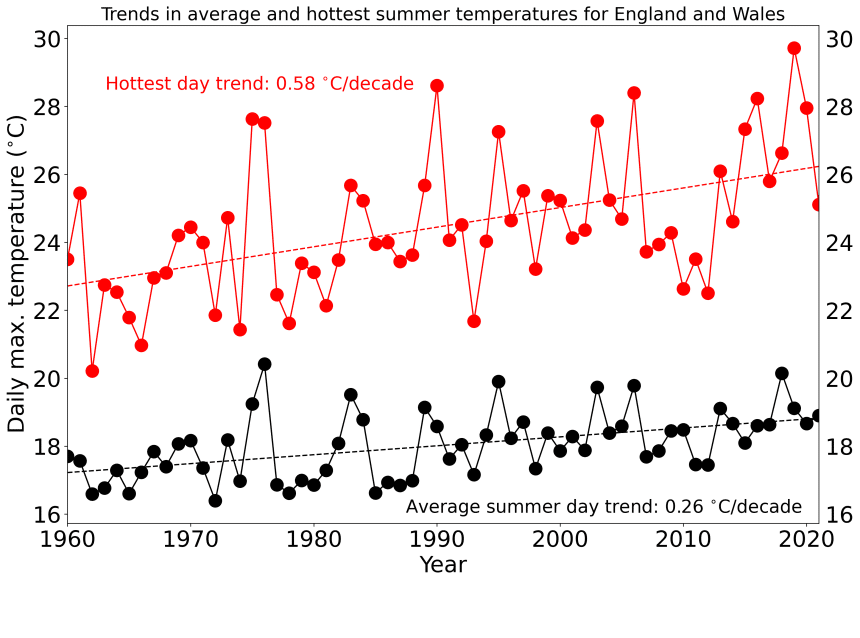Extremely hot days are warming twice as fast as average summer days in North-West Europe
Tuesday 16th May 2023, 9.51am
 Dr Matthew Patterson. Image credit: University of Oxford.
Dr Matthew Patterson. Image credit: University of Oxford.New research led by the University of Oxford has found that climate change is causing the hottest days in North-West Europe to warm at double the rate of average summer days. The difference in trends is most pronounced for England, Wales, and Northern France. Worryingly, while current climate models accurately predict the rate of warming for average days, they underestimate the rate at which the hottest days are warming compared to observations.
According to lead researcher Dr Matthew Patterson, from the University of Oxford’s Department of Physics, the results indicate that extreme heat events – such as the UK’s record-breaking heatwave last summer – are likely to become more regular. Dr Patterson said: ‘These findings underline the fact that the UK and neighbouring countries are already experiencing the effects of climate change, and that last year’s heatwave was not a fluke. Policy makers urgently need to adapt their infrastructure and health systems to cope with the impacts of higher temperatures.’
For the study, Dr Patterson analysed data from the past 60 years (1960-2021) recording the maximum daily temperature, provided by the European Centre for Medium-Range Weather Forecasts.
Although the maximum recorded temperature varied between years, the overall trend clearly showed that the hottest days for North-West Europe had warmed at twice the rate of average summer days. For England and Wales, the average summer day increased by approximately 0.26°C per decade, whilst the hottest day increased by around 0.58°C per decade. However, this faster warming of the hottest days was not observed to this extent elsewhere in the Northern Hemisphere.
The rapid warming of hot days relative to average days in north-west Europe is concerning and not yet fully understood. Scientists need to clarify the underlying mechanism in order to understand whether this pattern will continue into the future. Equally, these results show that the UK is already experiencing the effects of climate change and needs to adapt accordingly.
Dr Matthew Patterson, Department of Physics, University of Oxford
The reason causing this faster warming of the hottest days relative to average summer days is not yet understood. According to Dr Patterson, this may be due to the hottest summer days in North-West Europe often being linked to hot air transported north from over Spain. Because Spain is warming faster than North-West Europe, this means that air carried in from this region is ever more extreme relative to the ambient air in North-West Europe. The hottest days of 2022, for instance, were driven by a plume of hot air carried north from Spain and the Sahara. However, further research is needed to verify this.
Dr Patterson added: ‘Understanding the warming rate of the hottest days will be important if we are to improve climate model simulation of extreme events and make accurate predictions about the future intensity of such events. If our models underestimate the rise in extreme temperatures over the coming decades, we will underestimate the impacts this will have.’
Extreme heat has significant negative impacts on many different aspects of society, including energy and transport infrastructure, and agriculture. It also exacerbates conditions including respiratory and cardiovascular diseases, putting a strain on health services.
The current UK Government has been criticised by the Climate Change Committee (CCC) for failing to act quickly enough to adapt for the impacts of global heating. These new findings add even more urgency for policy makers to adapt infrastructure and systems vulnerable to extreme heat.
The study ‘North-West Europe hottest days are warming twice as fast as mean summer days’ has been published in Geophysical Research Letters.
 Time series of average summer (black) and maximum summer (red) daily maximum temperatures averaged over England and Wales, 1960-2021. Trend-lines are also shown for each time series. Image credit: Matthew Patterson, Department of Physics, University of Oxford.
Time series of average summer (black) and maximum summer (red) daily maximum temperatures averaged over England and Wales, 1960-2021. Trend-lines are also shown for each time series. Image credit: Matthew Patterson, Department of Physics, University of Oxford.

